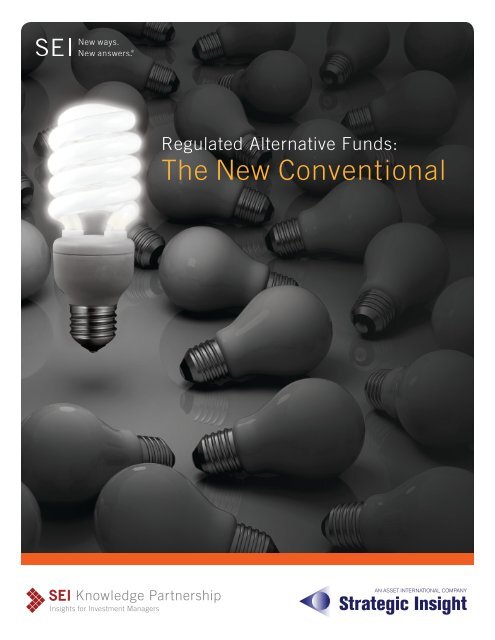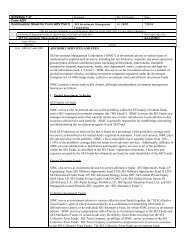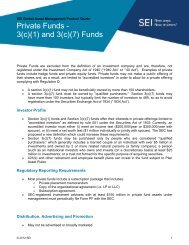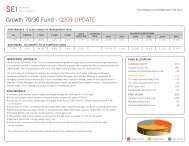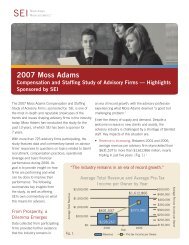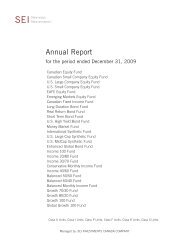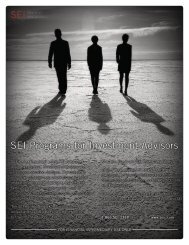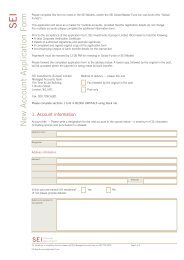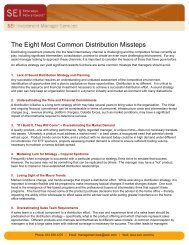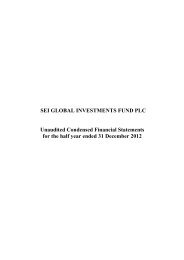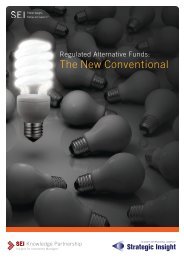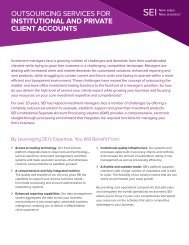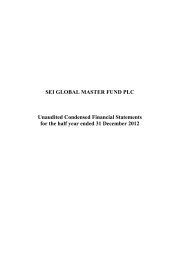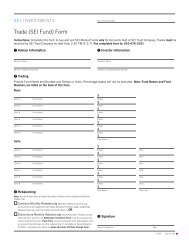Regulated Alternative Funds: The New Conventional - SEI
Regulated Alternative Funds: The New Conventional - SEI
Regulated Alternative Funds: The New Conventional - SEI
You also want an ePaper? Increase the reach of your titles
YUMPU automatically turns print PDFs into web optimized ePapers that Google loves.
<strong>Regulated</strong> <strong>Alternative</strong> <strong>Funds</strong>:<br />
<strong>The</strong> <strong>New</strong> <strong>Conventional</strong>
Preface<br />
One of the most visible changes in the global investment management industry post-crisis<br />
has been the new, sustained demand for “alternative” strategies and asset classes in retailfriendly<br />
fund structures. <strong>SEI</strong> and Strategic Insight first examined the growth of alternative<br />
mutual funds in a 2010 report, Exotic to Mainstream: Growth of <strong>Alternative</strong> Mutual <strong>Funds</strong><br />
in the U.S. and Europe. <strong>The</strong> further growth that paper predicted has come to pass, and<br />
many other conclusions still hold true today:<br />
• <strong>The</strong> trend toward “mainstream alternatives” holds substantial appeal for investment<br />
managers. For alternative managers, offering their strategies in a mutual fund structure<br />
opens up a substantially broader market opportunity. Meanwhile, traditional managers<br />
see an opportunity for increased fund flows, and potentially higher margins.<br />
• A diverse group of strategies, including long/short and global tactical asset allocation,<br />
and a varied group of managers are already experiencing success with these products.<br />
Sponsors continue to be geographically dispersed throughout Europe and the U.S.,<br />
and are beginning to emerge in Asia.<br />
• Managers entering this space must address expertise, regulatory, operational, and<br />
distribution considerations. Many of these factors can be central to the retail alternative<br />
effort, whether it’s a traditional manager who will need to acquire shorting skills, a firm<br />
whose strategies will have to be adapted to UCITS requirements, or an alternatives<br />
manager requiring a new, retail sales presence. <strong>The</strong> challenges can be daunting, but<br />
the opportunities in this fast-growing segment of the market are substantial.
Executive Summary<br />
In what is beginning to seem like the distant past, a<br />
clear line had once separated traditional and alternative<br />
investment products. But as investors faced multiple<br />
market crises and rising volatility, fund managers<br />
responded with a range of innovative products<br />
designed to better manage volatility and offer<br />
alternatives to long-only investing in traditional markets.<br />
As investor segments and products converge,<br />
alternative strategies are increasingly being packaged<br />
within registered fund structures originally designed for<br />
retail buyers, but also used by institutions and other<br />
fund selectors. A growing number of alternative funds<br />
are being launched as UCITS (Undertaking for<br />
Collective Investment in Transferable Securities), a fund<br />
vehicle accepted for sale in countries throughout the<br />
European Union and many other nations. <strong>Alternative</strong>s<br />
also are becoming more prominent within U.S. mutual<br />
funds (registered under the Investment Company Act of<br />
1940 or, in some cases, under the Securities Act of<br />
1933). <strong>The</strong> growing popularity of these funds is clearly<br />
evident in strong asset flows, product proliferation, and<br />
a growing presence in Asian markets.<br />
One factor driving the popularity of alternative UCITS<br />
and mutual funds is the detailed requirements around<br />
risk measurement and management, liquidity,<br />
counterparty diversification, and limits on leverage.<br />
However, the increased use of derivatives and their<br />
associated counterparty and operational risks continue<br />
to concern investors and regulators alike. <strong>The</strong> regulatory<br />
environment remains in flux as new rules on hedge<br />
funds take shape in Europe, and as the framework<br />
around UCITS gets reviewed amidst the expansion of<br />
more complex products. Yet this too is encouraging<br />
further innovation.<br />
Meanwhile, new frontiers are emerging. Europe and the<br />
U.S. have led the way in the adoption of alternative<br />
strategies, but other markets are developing a taste for<br />
non-correlated funds. One of the biggest retail fund<br />
launches in Japan this year was an alternative<br />
managed futures strategy. Demand for alternatives is<br />
growing among sovereign wealth funds and national<br />
pension funds in Asia, Latin America and the Middle<br />
East. Wealthy individual investors around the world are<br />
also expected to consider alternatives more seriously<br />
after their recent experiences with traditional asset<br />
classes. Although U.S. institutions and high net worth<br />
individuals (HNWIs) can access hedge funds and<br />
alternatives directly, they may see the benefits of<br />
sourcing such strategies through regulated structures,<br />
just as their European counterparts have done.<br />
REGULATED ALTERNATIVE FUNDS: THE NEW CONVENTIONAL<br />
“ Although U.S. institutions and high net worth<br />
individuals (HNWIs) can access hedge funds and<br />
alternatives directly, they may see the benefits<br />
of sourcing such strategies through regulated<br />
structures, just as their European counterparts<br />
have done. ”<br />
1
REGULATED ALTERNATIVE FUNDS: THE NEW CONVENTIONAL<br />
Key Findings<br />
<strong>The</strong> evolution of investment philosophies and strategies is causing previously distinct investor segments and products<br />
to converge. <strong>The</strong> trend of packaging alternative investment strategies within mutual funds and UCITS continues<br />
unabated, with new products being introduced regularly and asset flows gaining momentum. <strong>Regulated</strong> <strong>Alternative</strong><br />
<strong>Funds</strong>: <strong>The</strong> <strong>New</strong> <strong>Conventional</strong> offers an updated look at the dynamics of this rapidly evolving and maturing market,<br />
and shows how the popularity of these funds continues to rise around the world. Key findings include:<br />
• Global financial crises and continued market volatility using alternative strategies and managing a combined<br />
have transformed attitudes toward investing. As<br />
$254 billion of assets.<br />
managers respond to the evolving needs of investors<br />
• <strong>Alternative</strong> strategies through U.S. mutual funds and<br />
and their advisors, previously segregated products<br />
ETFs drew $39 billion in net inflows in the first eight<br />
and segments are converging.<br />
months of 2011, on pace to come near 2010’s $65<br />
• <strong>The</strong> convergence is seen in growing capital flows billion. By the end of August 2011, the U.S. had<br />
into regulated alternative investment products, most roughly 730 alternative mutual funds and ETFs,<br />
often in the form of UCITS funds and U.S.-registered 118 of which had been launched in the first eight<br />
mutual funds.<br />
months alone.<br />
• During the first eight months of 2011, more than $61<br />
billion poured into regulated funds using alternative<br />
strategies. With no slowdown of demand in sight,<br />
assets in alternative mutual funds and UCITS could<br />
hit the $1 trillion mark by 2014.<br />
• Growth is being driven by several factors. Investors<br />
are looking for ways to bolster portfolio performance,<br />
protect capital, and lower volatility. Traditional<br />
managers want to tap higher-fee areas. <strong>Alternative</strong><br />
managers would like to expand and diversify their<br />
client base.<br />
• <strong>Alternative</strong> strategies still account for a small portion<br />
of the UCITS and U.S. mutual fund markets, but<br />
they continue to capture increased market share.<br />
<strong>The</strong>y are also the most popular category in product<br />
development pipelines.<br />
• <strong>Alternative</strong> strategies inside UCITS attracted $22<br />
billion of net new flows in 2011 through August,<br />
following $50 billion in full-year 2010. Up until this<br />
summer’s volatility and impact on sales, gains were<br />
running at an even higher pace than last year. And<br />
2011’s flows came despite a 90% drop in overall<br />
flows into long-term UCITS during the same period.<br />
<strong>The</strong>re are now over 1,500 UCITS funds in Europe<br />
• Regulators remain concerned with the growth of<br />
derivatives use among regulated funds and have<br />
been reviewing derivatives policy for more than a<br />
year. <strong>The</strong> SEC has gone so far as to freeze most<br />
approvals of new funds and ETFs that rely heavily<br />
on derivatives, as it continues to conduct its review.<br />
• Investors and their advisors can be intimidated by<br />
these often-complex products. Active outreach and<br />
marketing campaigns are common among the retailoriented<br />
firms that dominate the space.<br />
• Assets in the regulated alternatives space tend to<br />
migrate to the largest professionally managed funds<br />
with the strongest performance. While performance<br />
matters for funds with track records, new unrated<br />
funds also get a large share of sales.<br />
• <strong>The</strong> future of alternative investments through<br />
regulated funds hinges to a large degree on robust<br />
risk management. Fund managers assume primary<br />
responsibility for implementing the necessary<br />
controls, but independent service providers also play<br />
important roles. Investors can also take some comfort<br />
in detailed regulatory requirements around risk<br />
measurement and management, liquidity,<br />
counterparty diversification, and limits on leverage.<br />
2
• Europe and the U.S. have been at the forefront of product innovation, but<br />
alternative strategies in regulated retail fund form are now appearing in<br />
other parts of the world. Opportunities for alternative managers are growing<br />
across Asia, Latin America, and the Middle East, driven by demand from both<br />
private investors and institutions.<br />
• Despite becoming increasingly competitive, the market for regulated alternative<br />
funds remains much more fragmented than traditional parts of the business, and<br />
no dominant players have yet emerged. As managers jockey for position and vie for<br />
the attention of investors, intermediaries, and gatekeepers, product innovation and<br />
distribution expertise will be key factors in determining the winners.<br />
• Partnerships that combine the investment expertise of existing alternative<br />
managers with the distribution prowess of traditional managers will become more<br />
common as managers of all stripes look for ways to gain a foothold in one of the<br />
most dynamic and growing parts of the asset management business.<br />
REGULATED ALTERNATIVE FUNDS: THE NEW CONVENTIONAL<br />
“ With no slowdown of demand in sight,<br />
assets in alternative mutual funds and<br />
UCITS could hit the $1 trillion mark<br />
by 2014.”<br />
3
REGULATED ALTERNATIVE FUNDS: THE NEW CONVENTIONAL<br />
<strong>The</strong> Convergence Factor<br />
Three major global financial market crises in a ten-year investment approaches. Retail investors and their<br />
span have dramatically transformed investor attitudes. advisors now are gravitating towards the greater diversity<br />
As a result, asset managers and advisors are grappling (and complexity) of alternative strategies that before<br />
with how to adapt to this new era. <strong>The</strong>ir responses, along were pursued mainly by institutional and high net worth<br />
with those of regulators and distributors, are redefining individuals. Institutions, meanwhile, continue to seek<br />
investment product structures.<br />
diversification through alternatives, but increasingly<br />
appreciate the transparency, liquidity, and regulatory<br />
A key facet of this evolution is the convergence of<br />
controls found within regulated pooled products,<br />
strategies previously segregated along retail versus<br />
previously associated primarily with retail investors.<br />
institutional lines as well as traditional versus alternative<br />
Another Year of Robust Inflows<br />
Convergence can be seen in the significant levels of<br />
capital that continue to migrate into alternative<br />
investment strategies found within regulated UCITS<br />
funds and U.S.-registered mutual funds. <strong>The</strong>re is no<br />
universally agreed-upon definition of “alternative”, but<br />
it can be applied to virtually any strategy that ventures<br />
beyond long-only investing in equities and debt<br />
instruments. This definition includes funds using hedge<br />
fund-like strategies or tactical allocation, and ranges to<br />
funds investing in commodities and currencies. During<br />
the first eight months of 2011, investors around the<br />
world put more than $61 billion into regulated funds<br />
using alternative strategies. This comes after $116<br />
billion of inflows into such funds during all of 2010.<br />
Figure 1: Net Flows into <strong>Alternative</strong> UCITS and Mutual <strong>Funds</strong>/ETFs<br />
20<br />
U.S. $Billions<br />
10<br />
0<br />
-10<br />
-20<br />
<strong>Alternative</strong> UCITS <strong>Funds</strong><br />
U.S. <strong>Alternative</strong> Mutual <strong>Funds</strong>/ETFs<br />
-30<br />
Jan'07 Dec'07 Nov'08 Oct'09 Sept'10 Aug'11<br />
Source: <strong>SEI</strong> Knowledge Partnership; Strategic Insight Simfund GL, MF<br />
Source: Strategic Insight Simfund GL, MF<br />
<strong>The</strong> industry is thus on track for 2011 to be another big<br />
year of flows into regulated funds with alternative<br />
strategies, with no slowdown of demand on the horizon.<br />
Indeed, assets in alternative mutual funds and UCITS<br />
could hit the $1 trillion mark in 2014—and double<br />
today’s $644 billion in 2016.<br />
As investors face an uncertain and more volatile<br />
economic future, they are recognizing the value that<br />
strategies around absolute and/or uncorrelated returns<br />
could provide as a way to help bolster portfolio<br />
performance, protect capital, and lower volatility.<br />
Meanwhile, traditional managers are launching long/<br />
short, absolute return, and other alternative funds<br />
to tap higher-fee growth areas, while alternative<br />
managers are launching regulated retail funds<br />
to expand and diversify their client base.<br />
<strong>Alternative</strong> strategies are the most popular category in<br />
asset managers’ product development pipelines with<br />
4
managers such as Altegris, BlackRock, PIMCO, Nuveen, <strong>Alternative</strong> investment strategies within both UCITS<br />
and First Eagle filing with the U.S. SEC to offer mutual funds and ‘40 Act mutual funds continue to grow even<br />
funds that rely on managed futures, long/short, credit, as the overall asset management industry faces more<br />
commodities, arbitrage, absolute return fixed income difficult business conditions. At the end of August 2011,<br />
and other alternative strategies. Even investment<br />
alternative strategies in UCITS and U.S. mutual funds/<br />
management firms without “alternative” fund offerings ETFs managed a combined $644 billion in assets, up<br />
are being affected, as they must navigate a marketplace 134% from the $275 billion at the end of 2006.<br />
that is being redrawn by the growth of such products.<br />
Figure 2: Assets in <strong>Alternative</strong> UCITS and Mutual <strong>Funds</strong>/ETFs<br />
700<br />
U.S <strong>Alternative</strong> Mutual <strong>Funds</strong>/ETFs <strong>Alternative</strong> UCITS <strong>Funds</strong><br />
600<br />
REGULATED ALTERNATIVE FUNDS: THE NEW CONVENTIONAL<br />
500<br />
U.S. $Billions<br />
400<br />
300<br />
200<br />
100<br />
0<br />
Jan'07 Dec'07 Nov'08 Oct'09 Sept'10 Aug'11<br />
Source: <strong>SEI</strong> Knowledge Partnership, Strategic Insight Simfund GL, MF<br />
Source: <strong>SEI</strong> Knowledge Partnership, Strategic Insight Simfund GL, MF<br />
What’s more, alternative strategies, although still a small<br />
portion of the UCITS and U.S. mutual fund markets,<br />
have continued to increase their market share. At the<br />
end of August 2011, alternative strategy funds’ AUM<br />
were 4.4% of “traditional” UCITS and U.S. funds’ AUM,<br />
up from 2.2% at the start of 2007. This is due to the fact<br />
that assets in traditional UCITS and U.S. funds have<br />
been growing at 3.6% per year since 2006, while assets<br />
in alternative strategy UCITS and U.S. mutual funds<br />
have been growing at 17% per year during that time.<br />
As Figure 3 shows, annual growth for alternative UCITS<br />
and U.S. funds handily outpaced the total industry’s<br />
growth in five of the past six years, and is on pace to<br />
do again this year.<br />
Figure 3: Asset Growth Rates: <strong>Alternative</strong> vs. Total UCITS & Mutual Fund Industry<br />
100%<br />
80%<br />
Total UCITS & U.S. Fund Industry<br />
<strong>Alternative</strong> UCITS & U.S. <strong>Funds</strong><br />
Annual Asset Growth Rate<br />
60%<br />
40%<br />
20%<br />
0%<br />
-20%<br />
-40%<br />
2005 2006 2007 2008 2009 2010 2011E*<br />
*Annualized<br />
Source: Strategic Insight Simfund MF, GL *Annualized<br />
Source: <strong>SEI</strong> Knowledge Partnership; Strategic Insight Simfund MF, GL<br />
5
REGULATED ALTERNATIVE FUNDS: THE NEW CONVENTIONAL<br />
One Third of UCITS Flows Go to <strong>Alternative</strong>s<br />
<strong>The</strong> remarkable progress of alternative strategies is <strong>Alternative</strong> UCITS funds have navigated this volatile<br />
evident in the substantial share of total industry gains environment without any meaningful operational<br />
they now capture, accounting for 39% of year-to-date or liquidity crises so far, a fact that is encouraging<br />
flows to all long-term actively managed UCITS, a confidence. Growing familiarity with the strategies,<br />
far higher proportion than many had anticipated. and acknowledgement by Europe’s fund industry that<br />
<strong>Alternative</strong> strategies inside UCITS attracted $22 the use of sophisticated investment techniques or<br />
billion of net new flows in the first eight months of derivatives do not necessarily imply higher risks 1 ,<br />
2011. This was achieved despite overall flows into suggest more supportive views on the long-term role<br />
long-term UCITS declining by over 90% during the of such products in the regulated retail world than<br />
same period.<br />
before. <strong>The</strong> industry and regulators alike nevertheless<br />
remain attentive to the potential risks of alternative<br />
Such gains are being facilitated by the emergence<br />
strategies, and are constantly reviewing additional<br />
of a few well-established alternative UCITS funds with<br />
protective measures.<br />
appealing track records, competitive returns, relatively<br />
transparent investment and risk management<br />
Efforts are underway in Europe to better identify<br />
strategies, and strong brands. <strong>The</strong> biggest individual the distinct strategies and hedge fund styles being<br />
product, Standard Life Global Absolute Return<br />
implemented in UCITS. One example is the recent<br />
Strategies, now has $13.6 billion in assets and is the introduction of more precise classifications by<br />
15th-largest long-term fund in Europe. In addition, independent fund information providers, a significant<br />
the top selling alternative UCITS new introduction improvement from the generic “absolute return”<br />
thus far this year is a SICAV version of this fund groupings used previously, which further promotes<br />
designed for cross-border distribution collecting over the professional selection, monitoring, and<br />
$1.5 billion. During the same period, PIMCO GIS benchmarking of regulated alternative funds and<br />
Unconstrained Bond, launched in December 2008, easier integration of them into investment portfolios.<br />
successfully raised nearly $3 billion in flows making<br />
it the best-selling alternative UCITS product to date<br />
in 2011. <strong>The</strong> growth and visibility of such alternative<br />
fund leaders are buoying faith among a broadening<br />
base of investors.<br />
“ <strong>The</strong> evolution of investment philosophies and<br />
strategies is causing previously distinct investor<br />
segments and products to converge. ”<br />
6<br />
1<br />
See “<strong>The</strong> Evolving Investment Strategies of UCITS”, European Fund and Asset Management Association, May 2011.
<strong>New</strong> European Launches Broaden the Field<br />
<strong>The</strong>re are now over 1,500 UCITS funds in Europe using <strong>The</strong> most successful offering in 2011 is the Standard<br />
alternative strategies and managing a combined $254 Life SICAV Global Absolute Return Strategies, which<br />
billion of assets 2 . Moreover, many of them have<br />
raised $1.5 billion in the eight months following its<br />
achieved a meaningful size, with 41 funds managing in launch. Others include Deutsche Asset Management’s<br />
excess of $1 billion and another 65 portfolios running DB Platinum IV dbX Systematic Alpha Index, which<br />
between $500 million and $1 billion apiece.<br />
captured $1.1 billion of net flows in the 12 months since<br />
its launch and the Solo Absolute Bond & Currency Fund<br />
<strong>The</strong> field is growing with new introductions and product<br />
from Natixis, which pulled in $750 million in the three<br />
range extensions. During the first eight months of 2011,<br />
months since its launch. Together these and other funds<br />
fund managers launched 170 new alternative UCITS,<br />
confirm a more robust evolution of demand for new<br />
collectively raising $10 billion from investors across<br />
alternative products than predicted after the relatively<br />
Europe and internationally.<br />
lackluster UCITS experiments by hedge fund managers<br />
<strong>New</strong> launches are also gathering greater assets than a year or two ago. See Figure 4.<br />
before. <strong>The</strong> amount raised in the first half of 2011 is<br />
a notable leap from the second half the previous year<br />
when new funds raised just $4 billion.<br />
REGULATED ALTERNATIVE FUNDS: THE NEW CONVENTIONAL<br />
Figure 4: Biggest <strong>Alternative</strong> UCITS and Mutual <strong>Funds</strong><br />
Morningstar Category<br />
Launch Date<br />
Net Flows<br />
$B YTD Aug ‘11<br />
Assets<br />
$B Aug ‘11<br />
Europe UCITS<br />
Standard Life Invsmts Glo Absolute Return Strat Alt—Multistrategy 2008 2.7 13.6<br />
Julius Baer BF Absolute Return-EUR B Alt—Long/Short Debt 2008 -0.6 7.8<br />
<strong>New</strong>ton Real Return A GBP Fund GBP Flexible Allocation 1993 2.5 7.0<br />
JP Morgan Income Opportunity A Acc EUR USD Flexible Bond 2007 2.1 7.0<br />
PIMCO GIS Unconstrained Bond Institl USD Acc USD Flexible Bond 2011 2.9 6.4<br />
U.S. <strong>Funds</strong><br />
<br />
SPDR Gold Shares Gold 2004 -2.4 71.8<br />
PIMCO Commdty Real Return Strategy Commodities 2002 2.4 27.6<br />
Ivy Asset Strategy World Allocation 1995 1.8 27.1<br />
iShares Silver Trust Silver 2006 -1.2 13.0<br />
iShares Gold Trust Gold 2005 2.5 9.7<br />
Source: <strong>SEI</strong> Knowledge Partnership; Strategic Insight Simfund GL, MF<br />
Though acceptance is spreading, many investors and<br />
intermediaries remain in the early stages of incorporating<br />
alternatives into their investment programs. This<br />
suggests much room for growth if regulated alternative<br />
funds continue to manage their risks, offer investors<br />
the same level of fundamental protections as other<br />
regulated products, and deliver reasonable results and<br />
value over time. And managers of these funds must<br />
help intermediaries and investors better understand<br />
the strategies and how they fit in a portfolio.<br />
2<br />
Strategic Insight has been tracking alternative strategies in UCITS for over half a decade, and now combines its own research with classifications from Morningstar, Lipper, and other<br />
specialist fund trackers who focus on the hedge fund style UCITS universe to determine the most relevant peer group of alternative investment funds.<br />
7
REGULATED ALTERNATIVE FUNDS: THE NEW CONVENTIONAL<br />
Gains in the U.S. Despite Challenges<br />
<strong>Alternative</strong> strategies through U.S. mutual funds and “microsites” devoted to particular alternative-strategy<br />
ETFs drew $39 billion in net inflows in the first eight products complete with whitepapers and videos in<br />
months of 2011, on pace to come near 2010’s $65 addition to fact sheets and regulatory filings. For<br />
billion. <strong>The</strong> “alternative” category, which comprises example, in early 2011, seven asset managers,<br />
multiple investment strategies and asset classes, is including Forward, JP Morgan and Eaton Vance,<br />
heterogeneous enough that when precious metals funds teamed up for a three-city road show aimed at<br />
in 2011 failed to continue the torrid sales of 2010, the explaining alternative-strategy mutual funds to<br />
slack in alternative fund flows was picked up by other independent registered investment advisors (RIAs).<br />
commodity funds and by alternative-style global tactical Still, these products can be hard to place in the huge<br />
asset allocation (GTAA) funds, a fast-growing category and highly regulated arena of defined-contribution<br />
whose funds may invest anywhere around the world in retirement plans, where plan sponsors tend to be<br />
any asset class, akin to global macro hedge funds. By conservative; but alternative-strategy funds are slowly<br />
the end of August, the U.S. had roughly 730 alternative gaining a toehold as sleeves within funds-of-funds in<br />
mutual funds and ETFs, 118 of which had been<br />
such plans.<br />
launched in the first eight months alone.<br />
In the retail-oriented U.S. market for alternative strategy<br />
Despite their momentum, alternative mutual funds face mutual funds, managers’ marketing and sales efforts<br />
several challenges. Like their colleagues across the often prioritize the independent RIAs, who tend to be<br />
Atlantic, the SEC has been concerned about the<br />
early adopters of alternative strategies and structures.<br />
regulatory and disclosure implications of the growth of Broker-dealers, the most important distribution outlet for<br />
derivatives use among mutual funds and has been mutual funds, also have a growing population of RIA-like<br />
reviewing derivatives policy for more than a year. <strong>The</strong> advisors: those who use a rep-as-portfolio manager<br />
agency has gone so far as to freeze most approvals platform. <strong>The</strong>se advisors have full discretion over client<br />
of new funds and ETFs that rely heavily on derivatives, assets and construct client portfolios rather than using<br />
as it continues to conduct its review.<br />
model portfolios provided by due diligence teams at their<br />
firm’s headquarters. Advisors utilizing this fast-growing<br />
Investors and their advisors can also be intimidated<br />
model are decidedly heavier users of alternative mutual<br />
by these often-complex products. Active outreach and<br />
funds (especially GTAA) and ETFs. <strong>The</strong>y also tend to<br />
marketing campaigns are common among the retailoriented<br />
firms that dominate the space. Money<br />
hold funds and ETFs for shorter periods than other<br />
advisors, so managers should recognize that there<br />
managers such as Putnam Investments have web<br />
is a trade-off for their early acceptance.<br />
8
Performance with Other Factors Driving Sales<br />
Similar to hedge funds and traditional long-only<br />
less. As a group, these low-rated funds suffered net<br />
managed funds, assets in the regulated alternatives redemptions, as Figure 5 illustrates 3 . We observed<br />
space migrate to the largest professionally managed similar relationships between performance and flows<br />
funds with the strongest performance. Sales results in practically all asset classes, markets, and time<br />
closely correspond with an individual fund’s absolute periods over the past 20 years.<br />
and relative results, and various measures of riskadjusted<br />
returns.<br />
While performance matters for funds with a track<br />
record, new unrated funds also get a large share of<br />
For example, among alternative UCITS with a track sales. This is especially true in the alternatives segment<br />
record, 69% of YTD 2011 flows went to funds with where many funds do not yet have long track records,<br />
Morningstar’s top 5-star risk-adjusted return rating, but where the manager might have a reputation running<br />
and another 28% of flows to products with a high similar strategies in another format. Views that newer,<br />
4-star rating—even though only a third of rated funds smaller funds could exercise greater flexibility and<br />
earned these star ratings. Most have three stars or potentially outperform larger funds may also play a role.<br />
REGULATED ALTERNATIVE FUNDS: THE NEW CONVENTIONAL<br />
Figure 5: <strong>Alternative</strong> UCITS Flows YTD Aug ’11 By Morningstar Rating*<br />
6.0<br />
5.0<br />
4.0<br />
U.S. $Billions<br />
3.0<br />
2.0<br />
1.0<br />
0<br />
-1.0<br />
5 4 3 2 1<br />
Morningstar Rating<br />
* Data reflects only funds with Morningstar ratings. Data does not include<br />
all alternative UCITS funds, in particular new funds without a rating.<br />
Source: <strong>SEI</strong> Knowledge Partnership; Strategic Insight Simfund GL<br />
3<br />
Based on Strategic Insight’s analysis through August 2011 of its own calculated flows within SI’s Simfund Global database, for the entire SI universe of alternatives, using Morningstar Ratings.<br />
9
REGULATED ALTERNATIVE FUNDS: THE NEW CONVENTIONAL<br />
Figure 6: <strong>Alternative</strong> and Traditional UCITS Fund Asset-Weighted Performance<br />
110<br />
105<br />
100<br />
95<br />
90<br />
85<br />
80<br />
<strong>Alternative</strong> Strategies<br />
Traditional Long-Term Assets<br />
75<br />
Dec ’06 Jun ’07 Dec ’07 Jun ’08 Dec ’08 Jun ’09 Dec ’09 Jun ’10 Dec ’10 Jun ’11<br />
Source: Strategic Insight asset-weighted calculations in Euro terms based on returns from Morningstar Inc and Lipper Inc Returns represent<br />
asset-weighted composites of Euro-base primary share classes only; traditional long-term assets excludes money markets and alternatives<br />
Source: <strong>SEI</strong> Knowledge Partnership; Strategic Insight asset-weighted calculations in Euro terms based on returns from Morningstar Inc and Lipper Inc<br />
Returns represent asset-weighted composites of Euro-based primary share classes only; traditional long-term assets exclude money markets and alternatives.<br />
More importantly, in Figure 6, the success of alternative<br />
UCITS coincides with returns that have matched<br />
traditional assets—with lower volatility—over the past half<br />
decade. From the viewpoint of a Europe-based investor,<br />
regulated alternative strategies lost only 7% during the<br />
year of the 2008 financial crisis, while traditional funds<br />
(equity, bond, balanced, and other long-term asset<br />
classes) suffered a 21% average loss on an assetweighted<br />
basis 4 . Though traditional assets delivered<br />
higher returns during the 2009 and 2010 calendar years,<br />
alternative UCITS achieved similar cumulative returns<br />
since the start of 2007, with lower volatility.<br />
Results appear even better for UK-based investors.<br />
<strong>Alternative</strong> UCITS in the UK returned 13% on an<br />
average asset-weighted basis in 2009 and 8% in 2010 in<br />
GBP terms which, along with these funds’ other<br />
attributes, proved appealing to local institutional<br />
investors and retail investors through IFAs.<br />
Comparing the performance of alternative UCITS versus<br />
unregulated offshore hedge funds is difficult, since most<br />
hedge funds and indexes are managed and reported<br />
on a U.S. Dollar basis, while alternative UCITS are better<br />
understood in Euro terms from the vantage point of<br />
European investors. In any case, most sophisticated<br />
investors do not necessarily expect results from<br />
regulated alternative vehicles to match or exceed<br />
unregulated leveraged hedge funds. Most instead weigh<br />
the potential performance tradeoff against the benefits<br />
of a regulated, transparent, and liquid vehicle, using<br />
recent years’ track records as a guide.<br />
Similarly, performance comparisons between U.S.<br />
alternative mutual funds and U.S. hedge funds are<br />
difficult, in part because the vast majority of the<br />
alternative mutual funds are—unlike in Europe—<br />
managed by traditional fund managers and are therefore<br />
not versions of existing hedge funds. <strong>The</strong> promise of<br />
alternative mutual funds in the U.S. has flipped in recent<br />
years. Prior to the financial crisis, the sale of alternative<br />
strategies relied heavily on the possibility of boosting<br />
alpha (potentially a risk enhancer). Since the crisis,<br />
alternative mutual funds have been positioned more<br />
as a means to reduce volatility and provide downside<br />
protection (potentially a risk reducer). This has been a<br />
particularly important feature given the tumultuous rise<br />
and fall of the equity markets—together with the low<br />
or no return fixed income market—throughout 2011.<br />
10<br />
4<br />
Asset-weighted average returns provide a better proxy of the experience of most investors, and thereby helps explain investor choices.
<strong>The</strong> Role of Risk Management<br />
<strong>The</strong> future of alternative investments through regulated ESMA, this summer, issued a consultation on the risks of<br />
funds, whether UCITS, ’40 Act mutual funds, or similar synthetic ETFs and structured UCITS, with implications<br />
structures around the world, will depend to a large for alternative strategies relying on derivatives. Among the<br />
degree on robust management of the many complex issues emerging from the process are proposals for<br />
risks of such strategies. <strong>The</strong> responsibility rests primarily separating UCITS into non-complex versus complex<br />
on the fund managers to implement the necessary products. In October, the European Commission’s review<br />
internal controls, but with the help of independent of the Markets in Financial Instruments Directive (MiFID<br />
service providers and with effective oversight by<br />
II) supported the distinction of structured UCITS as<br />
regulators and industry peer review.<br />
complex instruments, which would place certain<br />
restrictions on their availability to retail investors.<br />
<strong>The</strong> regulatory frameworks of both UCITS and U.S.<br />
mutual funds provided a strong foundation for risk <strong>The</strong> regulation and distribution of hedge fund-style<br />
management and investor protection. Investors seeking alternative UCITS will remain closely intertwined with<br />
alternative investment strategies following the 2008 evolving policy orientations on synthetic ETFs. <strong>The</strong> use<br />
financial crisis have found comfort in the detailed of derivatives and swaps in ETFs, a segment where<br />
requirements around risk measurement and<br />
synthetic products account for 65% of the European<br />
management, liquidity, counterparty diversification, and industry, is an increasingly visible issue that has led<br />
limits on leverage, while leaving sufficient flexibility to regulators other than ESMA to examine their<br />
implement a diverse range of strategies.<br />
counterparty, liquidity, and systemic risks 5 . <strong>The</strong><br />
spotlight on these risks has contributed to a shift in<br />
Yet the expanding use of derivatives and their associated<br />
European ETF flows in 2011, with more capital flowing<br />
counterparty and operational risks continues to concern<br />
to “physical” ETFs in recent months than to swapsbased<br />
“synthetic” ETFs. Clearly, industry players have<br />
investors and regulators alike. Regulators and industry<br />
associations are exploring additional measures to improve<br />
strong incentives to buttress confidence in derivatives<br />
internal controls and strengthen oversight. Last year, the<br />
use, and we believe the focus on this issue will help the<br />
Committee of European Securities Regulators (CESR)<br />
industry in the long run.<br />
provided guidance on risk management including<br />
counterparty risks. CESR has since been replaced by the<br />
European Securities and Markets Authority (ESMA), an<br />
independent EU authority that continues to actively<br />
assess these issues.<br />
REGULATED ALTERNATIVE FUNDS: THE NEW CONVENTIONAL<br />
“ <strong>The</strong> future will depend on robust management of the<br />
many complex risks of alternative strategies.”<br />
5<br />
See “Market Structures and Systemic Risks of Exchange-Traded <strong>Funds</strong>” from the BIS, April 2011.<br />
11
REGULATED ALTERNATIVE FUNDS: THE NEW CONVENTIONAL<br />
AIFMD Opens <strong>New</strong> Doors<br />
Earlier uncertainties around changing hedge fund<br />
regulations, particularly fears that the <strong>Alternative</strong><br />
Investment Fund Managers Directive (AIFMD or<br />
Directive) might create hardships for certain non-EU<br />
funds to conduct business in Europe, had prompted<br />
hedge fund managers to consider or launch alternative<br />
strategies within UCITS which sit outside the scope<br />
of the Directive.<br />
Questions still remain, but the final draft of the<br />
regulations as published in July 2011 is causing less<br />
worry for hedge fund managers than first feared.<br />
This is helping to dissipate the attention of hedge fund<br />
managers on UCITS as a way to get around the<br />
limitations of AIFMD. <strong>The</strong> positive development allows<br />
both alternative and traditional managers to consider<br />
various different vehicles—both offshore and onshore<br />
hedge structures as well as UCITS where appropriate—<br />
and choose the most suitable for their investment<br />
strategy and target clientele.<br />
Luxembourg and Ireland are adapting their respective<br />
laws on Specialized Investment <strong>Funds</strong> (SIFs) and<br />
Qualifying Investor <strong>Funds</strong> (QIFs)—both regulated<br />
product structures—to align with AIFMD, and to<br />
establish these vehicles as a suitable structure for<br />
hedge fund providers. <strong>The</strong>se and other EU-domiciled<br />
alternative investment funds (AIFs) offer transparency,<br />
liquidity and access to Europe’s investors while<br />
providing greater flexibility than UCITS, possibly making<br />
them preferable structures for certain hedge fund<br />
strategies and investor types. SIFs and QIFs are thus<br />
expected to grow in the coming years as AIFMD settles<br />
into place. Assets in Irish QIFs expanded 35% in 2010<br />
to end the year at $209 billion, while Luxembourg SIFs<br />
grew 39% to reach $292 billion. This suggests that<br />
investors put in about $102 billion combined of net<br />
new money into QIFs and SIFs.<br />
Despite the expected growth of AIFs as AIFMD takes<br />
effect, many hedge fund and mainstream asset<br />
managers will undoubtedly continue to recognize<br />
UCITS as an appropriate structure for many highly<br />
liquid and unleveraged alternative strategies. Wellmanaged<br />
alternative UCITS with the right distribution<br />
approach have proven that they can consistently attract<br />
a very high level of assets. Moreover, their popularity<br />
continues to grow among institutional and individual<br />
investors as well as fund selectors and advisors, as they<br />
seek less correlated investments, additional sources<br />
of capital appreciation and income potential.<br />
12
<strong>New</strong> Frontiers<br />
Europe and the U.S. have been at the forefront of<br />
product innovation, but alternative strategies in<br />
regulated retail fund form are now appearing in other<br />
parts of the world. Notably, the $2 billion launch in the<br />
2nd quarter 2011 of Nomura Global Trend in Japan,<br />
a fund based on Man AHL’s managed futures strategy,<br />
signals an important milestone in the spread of<br />
alternative strategies to the Asia region. <strong>The</strong> fund’s<br />
size would have been impressive under normal<br />
circumstances, but is all the more noteworthy given<br />
that fundraising occurred just after the country’s tragic<br />
earthquake and tsunami.<br />
<strong>The</strong> success of this fund will encourage additional<br />
launches of regulated alternative investment funds<br />
in Japan beyond the historic route<br />
of structured products and private<br />
placements. <strong>The</strong> mutual fund market<br />
in Japan is the single greatest source<br />
of new assets, with multi-billiondollar<br />
mutual funds introduced on<br />
a monthly basis. Thus, hedge fund<br />
and other alternative managers may<br />
increasingly consider building<br />
relationships in that market.<br />
<strong>Alternative</strong> strategies may benefit through adaptation<br />
to the needs of investors in new markets, to incorporate<br />
themes and features they find important. For instance,<br />
Nomura Global Trend was offered in three currency<br />
classes: (1) yen, (2) a basket of currencies driven by<br />
natural resources—Brazilian real, Australian dollar,<br />
and South African rand, and (3) a basket of Asian<br />
currencies. <strong>The</strong> natural resource currency class<br />
captured more than half of assets.<br />
Opportunities for alternative managers are growing<br />
across Asia, Latin America, and the Middle East, driven<br />
by demand from both private investors and institutions.<br />
In particular, sovereign wealth funds and national<br />
pension funds, many of them collecting new assets on<br />
a sustained basis, are considering greater<br />
alternative investments to put those<br />
assets to work and to diversify their<br />
traditional strategic mix. <strong>Alternative</strong><br />
managers are also expecting wealthy<br />
investors across Asia to consider<br />
alternatives more seriously now,<br />
following negative experiences over<br />
many years with other asset classes.<br />
REGULATED ALTERNATIVE FUNDS: THE NEW CONVENTIONAL<br />
13
REGULATED ALTERNATIVE FUNDS: THE NEW CONVENTIONAL<br />
Looking to the Future<br />
Growth in the global retail market by alternative UCITS<br />
and mutual funds will be spurred mostly by smaller<br />
institutional investors. In the U.S., a greater number of<br />
financial advisors are adding alternative funds to retail<br />
portfolios as risk and volatility management become<br />
higher priorities in advisor-client discussions. In Europe,<br />
retail and institutional investors alike are gradually<br />
migrating toward UCITS, attracted by the fact that they<br />
are relatively liquid, transparent, and regulated.<br />
However, it would be a mistake to view UCITS and ’40<br />
Act funds as some sort of panacea. <strong>The</strong>y work well as<br />
vehicles for some investment strategies, but illiquidity<br />
factors prevent them from working for other strategies.<br />
<strong>The</strong>y are ultimately just one more way for managers<br />
to expand their investor base.<br />
Despite this caveat, assets in alternative-strategy UCITS<br />
and U.S. mutual funds should top $1 trillion in 2014,<br />
assuming only modest performance gains over the next<br />
few years, and barring a dramatic bear market. By 2016,<br />
assets in such funds should more than double the<br />
current $644 billion. Absolute return, hedge fund-like<br />
strategies, and global tactical allocation funds are likely<br />
to be major drivers of this growth. Commodity funds may<br />
also grow as portfolio diversifiers, but demand is less<br />
certain as they often mirror erratic commodity price<br />
movements. Geographically, any slowdown in growth in<br />
the U.S. and Europe will likely be partly offset by growth<br />
in Asia and other newer regions.<br />
Figure 7: Projected Growth of <strong>Alternative</strong> UCITS and <strong>Alternative</strong> U.S. Mutual <strong>Funds</strong><br />
1,500<br />
1,250<br />
U.S. $Billions<br />
750<br />
600<br />
500<br />
250<br />
0<br />
2007 2008 2009 2010 2011E 2012E 2013E 2014E 2015E 2016E<br />
Source: Strategic Insight<br />
Source: <strong>SEI</strong> Knowledge Partnership; Strategic Insight<br />
14
Conclusion<br />
A market of $1 trillion or more, and growing at such<br />
a robust pace, means opportunities lie ahead for both<br />
retail and institutional managers interested in alternative<br />
strategies. With the development of regulated non-UCITS<br />
funds such as QIFs and SIFs as vehicles for alternatives,<br />
the market is even more substantial.<br />
As managers jockey for position and vie for the attention<br />
of investors, intermediaries, and gatekeepers, product<br />
innovation and distribution expertise will be key factors<br />
in determining the winners. And as the market matures,<br />
assets will ultimately coalesce around managers that are<br />
able to effectively combine both of these attributes with<br />
a sterling reputation, an institutional quality process,<br />
and proven performance.<br />
Traditional fund managers should be able to leverage<br />
their existing relationships with distributors as they roll<br />
out alternative funds. Those with experience in educating<br />
investors and advisors are likely to have an additional<br />
advantage that will enable them to secure additional<br />
market and mind share. Hedge fund managers wishing<br />
to enter the market for regulated alternative funds may<br />
prefer to find a retail-oriented manager with whom to<br />
partner or enter into a subadvisory relationship. Such<br />
partnerships, combining the investment expertise of one<br />
firm with the distribution prowess of another, will almost<br />
certainly become more common as managers of all<br />
stripes look for ways to gain a foothold in one of the<br />
most dynamic and growing parts of the asset<br />
management business.<br />
REGULATED ALTERNATIVE FUNDS: THE NEW CONVENTIONAL<br />
“As managers jockey for position and vie for<br />
the attention of investors, intermediaries, and<br />
gatekeepers, product innovation and distribution<br />
expertise will be key factors in determining<br />
the winners.”<br />
15
REGULATED ALTERNATIVE FUNDS: THE NEW CONVENTIONAL<br />
About <strong>SEI</strong><br />
<strong>SEI</strong> (NASDAQ:<strong>SEI</strong>C) is a leading global provider of investment processing, fund processing, and investment<br />
management business outsourcing solutions that help corporations, financial institutions, financial advisors, and<br />
ultra-high-net-worth families create and manage wealth. As of September 30, 2011, through its subsidiaries and<br />
partnerships in which the company has a significant interest, <strong>SEI</strong> manages or administers $395 billion in mutual<br />
fund and pooled assets or separately managed assets, including $162 billion in assets under management and<br />
$233 billion in client assets under administration. For more information, visit www.seic.com.<br />
<strong>SEI</strong>’s Investment Manager Services division provides comprehensive operational outsourcing solutions to support<br />
investment managers globally across a range of registered and unregistered fund structures, diverse investment<br />
strategies and jurisdictions. With expertise covering traditional and alternative investment vehicles, the division<br />
applies customized operating services, industry-leading technologies, and practical business and regulatory insights<br />
to each client’s business objectives. <strong>SEI</strong>’s resources enable clients to meet the demands of the marketplace and<br />
sharpen business strategies by focusing on their core competencies. <strong>The</strong> division has been recently recognized<br />
by HFMWeek as “Most Innovative Fund Administrator (Over $30bn AUA)” and “Best <strong>Funds</strong> of Hedge <strong>Funds</strong><br />
Administrator (Over $30bn AUA)” in both the U.S. and Europe. Additionally, <strong>SEI</strong> has been recognized as “Service<br />
Provider of the Year” by the Money Management Institute, among other industry awards.<br />
<strong>The</strong> <strong>SEI</strong> Knowledge Partnership is an ongoing source of action-oriented business intelligence and guidance for <strong>SEI</strong>’s<br />
investment manager clients. It helps clients understand the issues that will shape future business conditions, keep<br />
abreast of changing best practices, and develop more competitive business strategies. <strong>The</strong> Partnership is an initiative<br />
of <strong>SEI</strong>’s Investment Manager Services division.<br />
About Strategic Insight<br />
Begun in 1986, Strategic Insight is a competitive intelligence source for the investment management industry,<br />
providing clients with in-depth studies, consultation, and electronic decision support systems. SI assists over<br />
250 organizations worldwide, including the largest mutual fund management companies operating in the U.S. and<br />
the largest insurance companies serving the VA business. SI clients are responsible for about 90% of all U.S.<br />
mutual fund assets. Strategic Insight also helps over 60 of the world’s largest asset managers expand in Europe and<br />
Asia. Simfund, SI’s proprietary databases of mutual fund, ETF and VA information, are the most comprehensive in<br />
the industry and integrate data on historical assets, net flows, performance information, fees and expenses, and<br />
many more metrics. Strategic Insight has offices in <strong>New</strong> York, Boston, London, Hong Kong, and Melbourne.<br />
For more information, visit our home at www.sionline.com. SI’s parent, Asset International, is an information<br />
provider to financial-services institutions, including asset managers, global pensions, and others.<br />
16
1 Freedom Valley Drive Oaks, PA 19456 610-676-1270<br />
www.seic.com/ims | managerservices@seic.com<br />
<strong>The</strong> Investment Manager Services division is an internal business unit of <strong>SEI</strong> Investments Company. This information is provided for<br />
educational purposes only and is not intended to provide legal or investment advice. <strong>SEI</strong> does not claim responsibility for the accuracy<br />
or reliability of the data provided. Information provided by <strong>SEI</strong> Global Services, Inc.<br />
© 2011 <strong>SEI</strong> 111574 (11/11)


